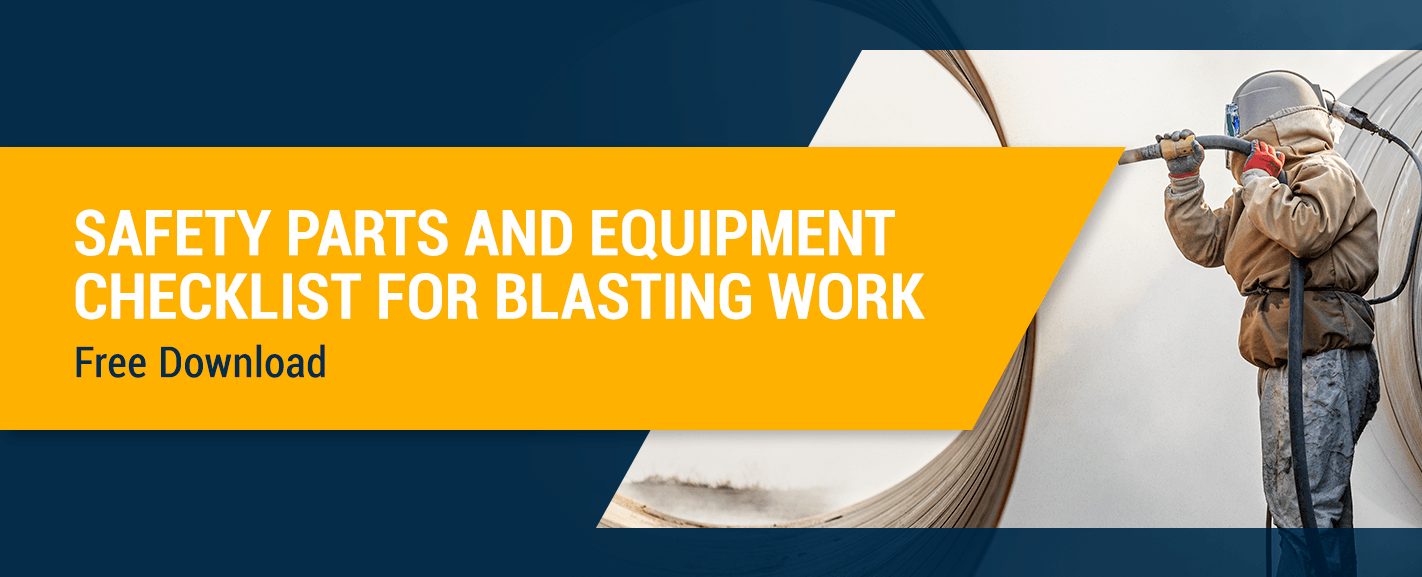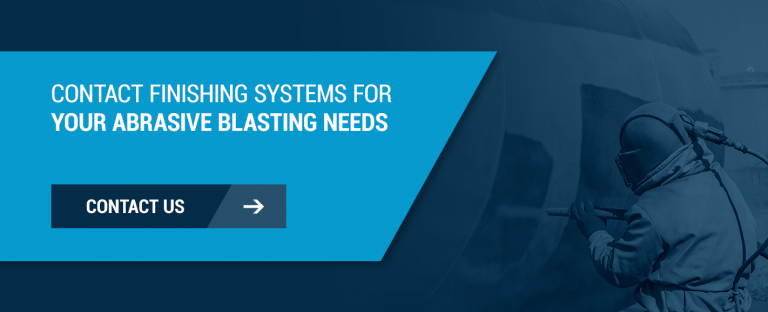
Abrasive Blasting Checklist
Last Updated: March 20, 2023
Abrasive blasting is widely used across industries like shipbuilding and automotive manufacturing. It helps companies efficiently prepare and clean various surfaces for paint or sealant applications. However, because of its high-pressure nature, safety is paramount when using abrasive blasting equipment.
Employers must ensure workers are equipped with the correct gear and that the equipment is regularly inspected and maintained. Proper safety equipment not only protects workers but also boosts productivity by allowing employees to focus on their tasks without worry.
At Finishing Systems, we provide reliable, high-quality abrasive blasting safety equipment to keep you and your team safe. Let’s explore some of the top hazards associated with abrasive blasting and how our safety equipment can help prevent accidents.
Contact Us
What Is Abrasive Blasting?
Abrasive blasting, often referred to as sandblasting, involves propelling a high-pressure stream of abrasive materials onto a surface using compressed air or water. The purpose could be cleaning, rust removal, surface preparation for painting, or adding texture.
What Materials Are Used for Abrasive Blasting?
There are numerous materials suitable for abrasive blasting, each chosen based on the coating requirements and application type. Here are some common materials:
- Glass Beads: Made from recycled glass, glass bead abrasives are eco-friendly and effective for cleaning without damaging the substrate.
- Crushed Glass: Sharp-edged crushed glass is perfect for heavy coating removal.
- Aluminum Oxide: A versatile abrasive used in everything from rust removal to glass etching.
- Plastic: Lightweight and non-silica plastic abrasives are ideal for delicate surfaces.
- Silicon Carbide: Known for rapid cutting speeds, silicon carbide is both efficient and cost-effective.
- Steel Shot: Extra-strong and durable, steel shot is great for heavy-duty tasks.
- Steel Grit: Angular-shaped steel grit creates strong anchor patterns for better coating adhesion.
- Starblastâ„¢: A blend of staurolite sands with low silica content, offering uniform blasting patterns.
- Black Beauty®: A coal slag product with minimal silica, Black Beauty is chemically inert and effective for various substrates.
- Walnut Shells: Biodegradable and gentle, walnut shells are perfect for sensitive applications.
- Corn Cobs: Similar to walnut shells, corn cobs are soft and useful for polishing jewelry or boat hulls.
What Are Some Hazards of Abrasive Blasting?
Abrasive blasting is far more efficient than manual methods like sanding or brushing. It's essential for preparing surfaces before painting or applying protective coatings. However, it comes with several risks, including:
- Toxic Air Contaminants: Exposure to harmful particles can lead to respiratory issues. Materials like silica sand can increase lung cancer risk, while metals like arsenic and lead are particularly dangerous.
- Noise: Operators are exposed to loud noises, potentially causing hearing loss if not properly protected. Typical blasting procedures produce sound levels between 112 to 119 dBA.
- Particle Streams: High-speed particles pose a risk of injury, including cuts, burns, or particle embedding in the skin or eyes.
- High-Pressure Streams: Inadvertently coming into contact with pressurized air or water streams can result in severe injuries.
- Static Electricity: Incorrect grounding of equipment can lead to electric shocks.
- Vibration: Long-term use can cause vibration syndrome, characterized by tingling, numbness, and pain in the hands and arms.
- Slippery Surfaces: Operators may experience slips due to abrasive particles on the ground.
- Heat Stress: Wearing protective gear for extended periods or working in hot environments can lead to heat-related illnesses.
Safety Equipment Checklist

Â
Using the right personal protective equipment (PPE) can significantly reduce the risks involved in abrasive blasting. At Finishing Systems, we offer top-notch safety equipment to keep you and your team safe. Here’s what you should include in your safety checklist:
- Respirator: Protects against toxic particles. We offer air-supplied respirators and helmets with integrated hearing protection.
- Climate Control Device: Helps regulate temperature inside respirators, preventing overheating and ensuring comfort during long shifts.
- Eye and Face Protection: Essential for shielding eyes and face from abrasive particles.
- Gloves: Heavy-duty gloves made of durable materials like canvas or leather are recommended. They should prevent abrasion and vibration impacts.
- Apron or Blast Suit: Full-body protection is crucial. Consider breathable yet robust blast suits that cover the arms and torso.
- Safety Shoes: Look for steel-toe boots that resist punctures and slips. Slip-resistant features are also important.
- Hearing Protection: If your respirator doesn’t include hearing protection, ensure workers wear earplugs or earmuffs.
Starting Every Project Safely
Each abrasive blasting project should begin with a thorough safety inspection. Here’s a checklist to guide you through inspecting equipment, surroundings, and PPE:
Blasting Equipment
A typical system includes an air compressor, air supply hose, abrasive blaster, blast hose, and blast nozzle. Ensure the following:
Air Compressor
The air compressor powers the equipment. Key points to verify:
- Is the compressor serviced and maintained?
- Does it have a pressure relief valve?
- Meets air supply needs?
- Positioned upwind of operations?
- Kept at a safe distance from the equipment?
Blast Vessel
This tank holds compressed air and abrasive material. Questions to ask:
- Free of corrosion, cracks, or dents?
- Inside free of moisture and debris?
- No leaks present?
- Depressurized before loading?
Valves, Hoses, Pipes, Wires, and Fittings
These components endure significant stress. Regular inspections are vital:
- All components free of leaks, cracks, or damage?
- No soft spots in hoses?
- Gaskets free of leaks?
- Whip checks and safety pins installed?
- Blast hose three to four times the nozzle size?
Blast Nozzle
Nozzle size affects airflow and material flow. Inspect:
- Nozzle threads or jackets intact?
- Sized appropriately for the task?
- Orifice size increased by 1/16 inches? Replace if necessary.
Abrasive Materials
Before starting, review the materials you'll use:
- Compatible with the equipment?
- Free of debris?
- Material MSDS reviewed?
- Non-toxic or acceptable toxicity levels?
- Dry and ready for use?
Objects
Secure the object and ensure:
- Object is stable?
- Only non-flammable materials stored?
Environment
Assess the work area:
- Hazardous blasting zones established?
- Electrical lines protected?
- No tripping, falling, or crushing hazards?
- Well-lit work area?
- Adequate ventilation?
- Machine on level ground?
- Static electricity discharge measures in place?
- Flammable fumes absent?
- Carbon monoxide monitor tested?
PPE
Ensure workers wear proper PPE:
- Respirator meets NIOSH standards?
- Respirator covers neck, head, and shoulders?
- Filters meet OSHA Grade D breathing air standards?
- Respirator undamaged?
- Eye protection in good condition?
- Gloves and footwear free of tears?
- Ear protection available?
Personal Hygiene During Projects
Maintain cleanliness to stay safe:
- No eating, drinking, or smoking in blasting areas.
- Install handwashing stations.
- Remove contaminated clothing before eating or smoking.
- Provide showers and changing rooms post-shift.
- Keep contaminated gear away from clean areas.

Contact Finishing Systems for Your Abrasive Blasting Needs
Abrasive blasting prepares surfaces efficiently for painting or coating applications. By using proper PPE and maintaining equipment, you can enhance productivity while ensuring safety. Finishing Systems provides everything you need to blast safely—from abrasives to portable equipment. Our commitment is to help you succeed. Contact us today to learn more!
Â
Download the Checklist
Custom Pall Rings
Custom Pall Rings,Ceramic Bauer Ring,Heat Resistance Ceramic Pall Ring,Ceramic Pall Ring
Wuxi Qijing Machinery Technology Co., Ltd. , https://www.sinombbrmedia.com


